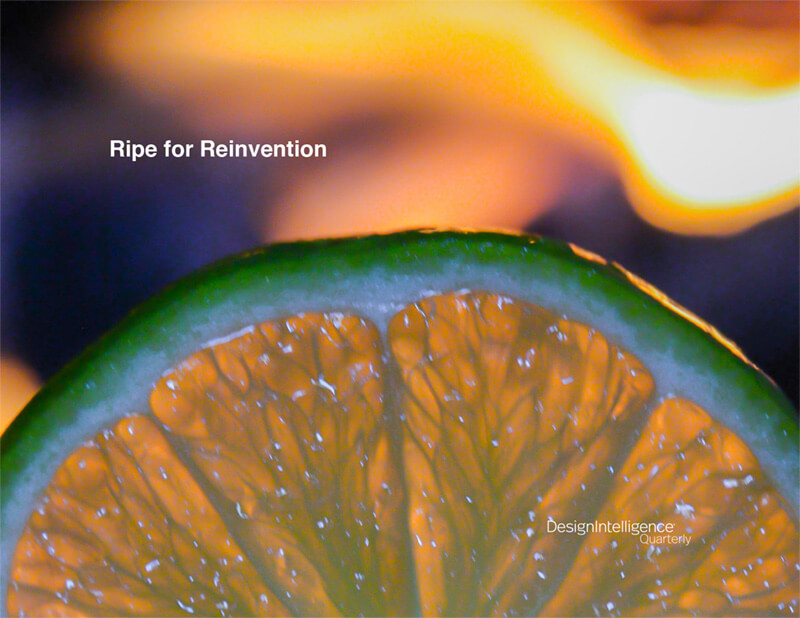Ripe for Reinvention
by Scott Simpson
FAIA & Senior Fellow in the Design Futures Council
November 17, 2020
Scott Simpson posits “life cycle value” and service as new mindsets for design thinking in an industry ripe for change.
Covid-19 has had a huge impact on the A/E/C industry. In the early stages of the pandemic, construction in some markets was shut down entirely. Design firms began living on backlog and with new projects so scarce, many firms experienced significant layoffs. The talent pipeline is drying up, as there are no jobs for new graduates. While things have started to rebound somewhat, it is clear going forward that the demand for many project types (especially retail, hospitality, and office space) will be particularly hard hit, and it could take several years to recover. This is not a time for business as usual.
That said, the Covid-19 crisis is not the only—nor even the most important—reason design and construction are ripe for reinvention. For decades, the A/E/C industry has severely underperformed other industries in process innovation and productivity. Annual expenditures for construction in the US are approximately $1 trillion—a significant slice of the GDP. However, one third of all projects still do not meet budget or schedule and 30% of construction materials wind up as waste, costing the economy $300 billion per year in aggregate. Compare that to the $50 billion architects bill annually, and the scale of the problem becomes immediately apparent. What’s more, buildings account for about 45% of all carbon emissions. In short, while we may be spending way too much time and money in how we design and construct buildings, at least we are polluting the environment in the process!
Changing times always bring new opportunities. For far too long, design has been a transactional business. Architects get paid for their services before the project is completed, which is why the primary focus during contract negotiations is on budget and schedule. For owners, first cost dominates the discussion. However, the value of a project does not begin to accrue until after the ribbon is cut and the building is put into service. Most owners don’t realize: the up-front capital cost is just 10% of the long-term operations and maintenance (O&M) cost over the 30 to 50-year lifespan of a typical structure. Instead of worrying mostly about minimizing first cost, owners should be focused on the project economics over the long haul. That’s where the real money is.
In that context, it stands to reason designers should be acutely interested in what happens during occupancy, using life cycle cost as a design tool. Ironically, that’s not how architects sell nor get paid for their services. Compare that approach to the business models of other artists such as singers, songwriters, or authors, who receive royalties and/or a percentage of the profits for their efforts. Their value propositions are based on long term value, not short-term results. Call it life cycle value. Design professionals should be thinking along the same lines. This would do two things: save money up front for clients (making it easier to finance their projects) and provide a stable income stream for design firms over the useful life of a project (putting them on a sound financial footing and dampening the effect of boom-and-bust business cycles).

It’s time architects understood the real value proposition that underlies design - and organize their efforts accordingly. They can start by broadening the definition of “design.” For too long, architects have viewed buildings mostly as static objects (“nouns”). Massing and materiality ruled the day. All well and good, but there’s more to the built environment than physical appearance. In fact, the legal basis for professional licensure is the architect’s responsibility to safeguard the “health, safety and welfare” of the public. Color, texture, and playful geometry don’t enter into that discussion. We need to expand our definition of design to include processes as well as products—the how as well as the what (“verbs”). For example, if a skilled architect can design a nursing unit in a hospital that can operate safely and effectively with fewer staff, everyone benefits. Patient outcomes would be improved, the stress on staff would be reduced, and a great deal of money would be saved for the institution.
Doing this requires an intimate knowledge of how space is used inside buildings—what works, what doesn’t, and how much things really cost. There’s much we don’t yet understand about how to maximize building performance. Developing a deep understanding will demand collection and analysis of all sorts of data. So far, design professionals are woefully behind in this regard. Just compare the amount of data collected about building occupancy with how thoroughly our shopping preferences are analyzed by Amazon. New ways of gathering and interpreting data will equip designers to address myriad questions:
- How can good design enhance productivity in offices, factories, and airports?
- How can it improve learning outcomes in schools? How can it increase attendance at museums?
- How can it increase safety and security in the public realm?
- What role might physical design play in improving public health?
That last question is particularly pertinent in the context of Covid-19.

Broadening the definition of design to include both process and product (verbs and nouns) will increase problem-solving opportunities exponentially. Need to know how to increase occupancy in your hotel? Want to get more foot traffic in your store? Looking to fill the freshman class at your university? Design thinking can help answer these questions and lead us in new directions.
New tools and technologies can help, but the A/E/C industry is woefully behind in taking full advantage of them. BIM technology is mostly viewed as a fancy drafting system rather than an information management tool. The sophisticated logistics employed by major corporations such as Walmart and Amazon are rarely deployed on typical construction sites. Paper-based design documents still litter construction trailers. Drones, robotics, and 3-D printing remain relative novelties in design studios and jobsites. The promise of pre-fabrication at large scale remains elusive. If we compare the level of technology adoption in design and construction to other major industries, such as manufacturing, retail, communications, or entertainment, it’s easy to see: the A/E/C industry lags far behind. Given the choice to use a hammer or a nail gun, we tend to choose the hammer.
As an example of how powerful technology can be, consider electronic gaming, which has grown exponentially since its inception just a few years ago. It’s now possible to create remarkably realistic electronic environments (now known as the “metaverse”) which can be populated with avatars and manipulated at will. If applied to design and construction, the technology would allow us to test all manner of alternatives quickly and objectively. Algorithms could maximize building performance while minimizing lifecycle cost, and the quality of design would improve. The implications for designers—and their clients—are immense.
The reasons for change in the A/E/C industry are clear. The opportunity is at hand. There is already plenty of money in the system to enable widespread process improvement—all we need do is re-deploy the $300 billion being left on the table every year and convert wasted dollars into productive ones. Best of all, we needn’t upend the entire industry to make significant improvements. A few tweaks will do the trick:
- Gather real-time data about building occupancy, and use that new knowledge to enhance both design and building performance.
- Change standard contract language from transactional to life-cycle value, lowering up front cost while extending the revenue stream for design firms.
- Add process design to the menu of standard services.
- Consciously include health, safety, and welfare as specific, expressly-stated design goals in all projects.
- Embrace the full potential of technology in design and construction.
Embracing new ways of thinking about design—the why, the what, and the how—will require a fresh look at how architects and engineers are trained. Currently, it takes about seven years to satisfy the basic requirements for licensure, and many more years after that before new graduates are truly proficient. We can start sooner (by introducing courses in design thinking in secondary school) and we can re-design how design is taught, including exposure to such topics marketing, management, and finance - all essential to long-term success. There is tremendous upside to improving how we design, engineer, and construct our built environment – and we don’t have to wait for a crisis to get started, it’s already upon us.
Let’s begin.
Scott Simpson, FAIA is a Senior Fellow in the Design Futures Council and a regular contributor to DesignIntelligence.


